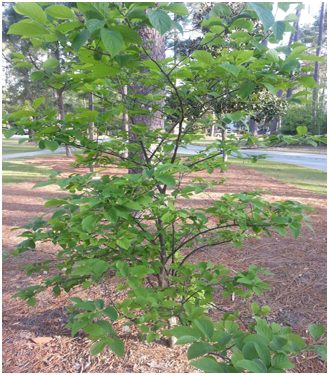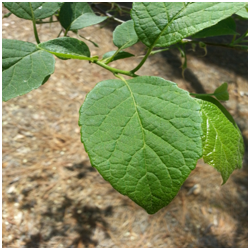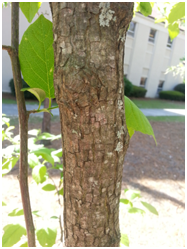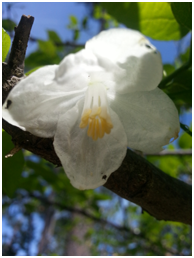Two-winged Silver Bell
Halesia diptera

(Photo by Shenice Price)
View the Location on Campus
Taxonomy (2)
Classification: Angiosperm, dicot
Family: Styracaceae
Common name: Two-winged Silver Bell
Varieties: magniflora
General Information (1,2,3)
Region of Origin: Eastern Asia
USDA Plants Hardiness Zones: 6-9
Growth Habit: Shrub or small tree
- Size: up to 30 feet tall
- Deciduous/Evergreen: Deciduous
- Flowering: early Spring
- Fruiting: Summer and Fall
Diagnostic Characteristics
Leaves (1,2)
- Arrangement: Alternate
- Simple/Compound: Simple
- Shape: Elliptic-obovate
- Other: 3-5 inches long

(Photo by Shenice Price)
Stem/Bark (4)
- Color: Gray to brown
- Texture: Ridged and furrowed, scaly

(Photo by Shenice Price)
Flower (2)
- Color: White
- Size: 3/4-1 inch long

(Photo by Shenice Price)
Fruit (1,2,3)
- Fruit type: Dry drupe
- Size: 1.5-2 inches long
- Color: Green to brown
(Photo by Jessica Bartek)
Horticultural Information (2,3,4)
- Light: Full sun
- Soil type: Loamy or sandy
- pH: Slightly acidic
- Maintenance: Little maintenance required
- Landscape Uses: Ornamentals
- Other: Do not add lime to Silver Bell's substrate
Interesting Facts (1,3)
- Withstood -25°F in Cincinnati and flowered profusely.
References
- Dirr, M. (1998). Manual of woody landscape plants: Their identification, ornamental characteristics, culture, propagation and uses (5th ed.). Champaign, Ill.: Stipes Pub.
- Steve Christman. (06/20/97). Halesia spp. Floridata. April 1, 2013, from http://www.floridata.com/ref/h/hales_c.cfm
- Everett, T. H., & New York Botanical Garden. (1980). The New York Botanical Garden illustrated encyclopedia of horticulture. New York: Garland Pub.
- M. Ritter, W. Mark, J. Reimer and C. Stubler(n.d.). "Halesia diptera Tree Record.". Selectree.. April 2, 2013 from http://selectree.calpoly.edu/treedetail.lasso?rid=688&-session=selectree:AD1CE0F40a54927BB5hiSiAEC5B3
Prepared by Shenice Price as a course requirement for BIOL 3630/5630, Spring 2013
Edited by Jessica Bartek
Edited by Jessica Bartek
Department of Biology
-
Room 2035, 2nd Floor
Bailey Science Building -
Mailing Address
1500 N. Patterson St.
Valdosta, GA 31698 - Phone: 229.333.5759
- Fax: 229.245.6585
Monday - Thursday
8:00AM until 5:30PM
Friday
8:00AM until 3:00PM
Saturday - Sunday
Office Closed